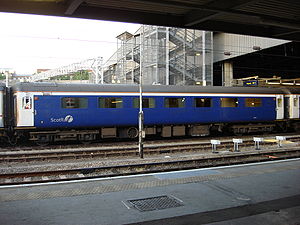British Rail Mark 2
| British Rail Mark 2 | |
|---|---|

|
|
| In service | 1964–present |
| Manufacturer | British Rail Engineering Limited |
| Built at |
Prototype: Swindon Works, Production: Derby Carriage and Wagon Works |
| Constructed | 1963–1975 |
| Entered service | 1964 |
| Number built | 1,876 |
| Operator(s) |
Abellio Greater Anglia Caledonian Sleeper Abellio ScotRail DB Cargo UK Direct Rail Services Network Rail Riviera Trains West Coast Railway Company |
| Specifications | |
| Car body construction |
Steel Semi-integral |
| Car length | 64 ft 6 in (19.66 m) |
| Doors | Hinged slam, centrally locked |
| Maximum speed | 100 mph (161 km/h) |
| Train heating | Pressure Ventilation Air Conditioning (1971 onward) |
| Bogies | B4 or B5 |
| Braking system(s) | |
| Track gauge |
1,435 mm (4 ft 8 1⁄2 in) standard gauge 1,600 mm (5 ft 3 in) (NIR IÉ) 1,067 mm (3 ft 6 in) NZ TR 1,000 mm (3 ft 3 3⁄8 in) metre gauge (KRC) |
The Mark 2 family of railway carriages were British Rail's second design of carriages. They were built by British Rail workshops (from 1969 British Rail Engineering Limited) (BREL) between 1964 and 1975. They were of steel construction.
The Mark 2 has a semi-integral construction, giving it more strength than a Mark 1 in the event of an accident, although a key driver of the changed construction method was to overcome the serious corrosion problem point in the Mark 1 at the base of the body, where it was attached to the underframe. Other changes of design, such as the window units, were for the same reason, which had become a serious problem in Mark 1 vehicle maintenance costs. Revised painting methods were also part of this, which coincided with the change of livery from maroon (dark green on the Southern) to the blue and grey that Mark 2 coaches wore for much of their lives (some of the earliest Mark 2 coaches had the old livery at first).
The Mark 2 coach was one of the mainstays of the InterCity network, but new rolling stock introduced in the post-privatisation era has resulted in most being withdrawn.
Since their withdrawal from most main line duties, Mark 2 coaches have played an increasing role on private rail tours, charter trains, and on heritage railways. Since 1996, over 140 Mark 2 carriages have been exported to New Zealand, where they are still in mainline service (as of 2013).
The prototype Mark 2, FK 13252, was built in 1963, now preserved by the National Railway Museum and located at the Mid-Norfolk Railway.
The final Mark 2 carriage was departmental 999550, in 1977. As of 20 July 2009[update] it is still in service with Network Rail as a Track Recording Coach. The later versions (2D onwards) look somewhat similar to the later Mark 3 design. The Mark 3 is longer (75 feet as opposed to 64 feet 6 inches), has a large skirting between the bogies to conceal the ancillary equipment, and has a ridged roof as opposed to the smooth roof of the Mark 2. The development of the High Speed Train overlapped with that of the final production run, and the Mark 2F "previewed" many features incorporated into the Mark 3, such as new seating, plastic interior panelling, and floor-sensor-operated automatic gangway doors.
...
Wikipedia
